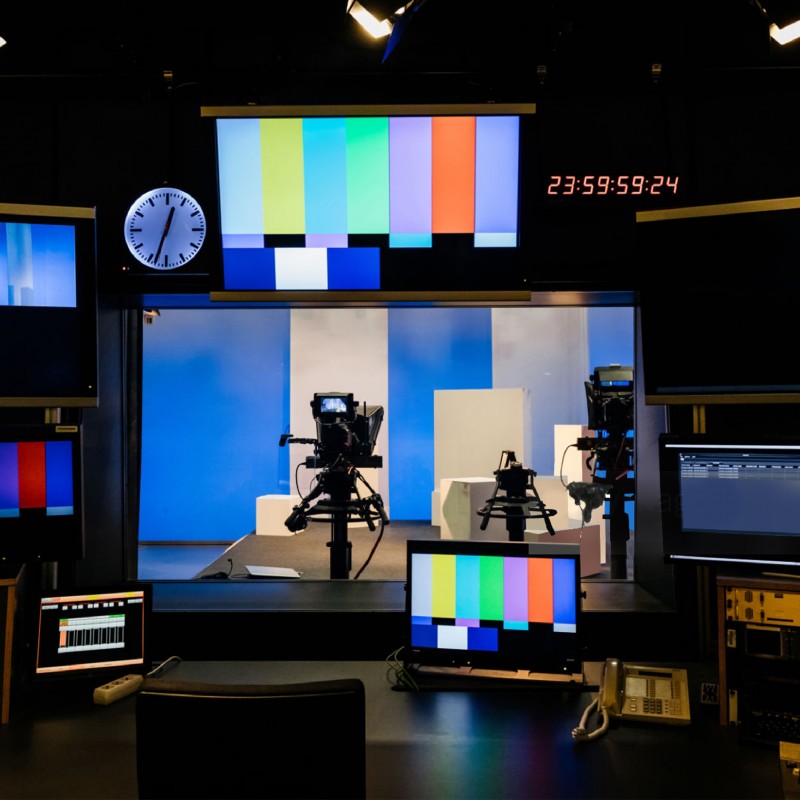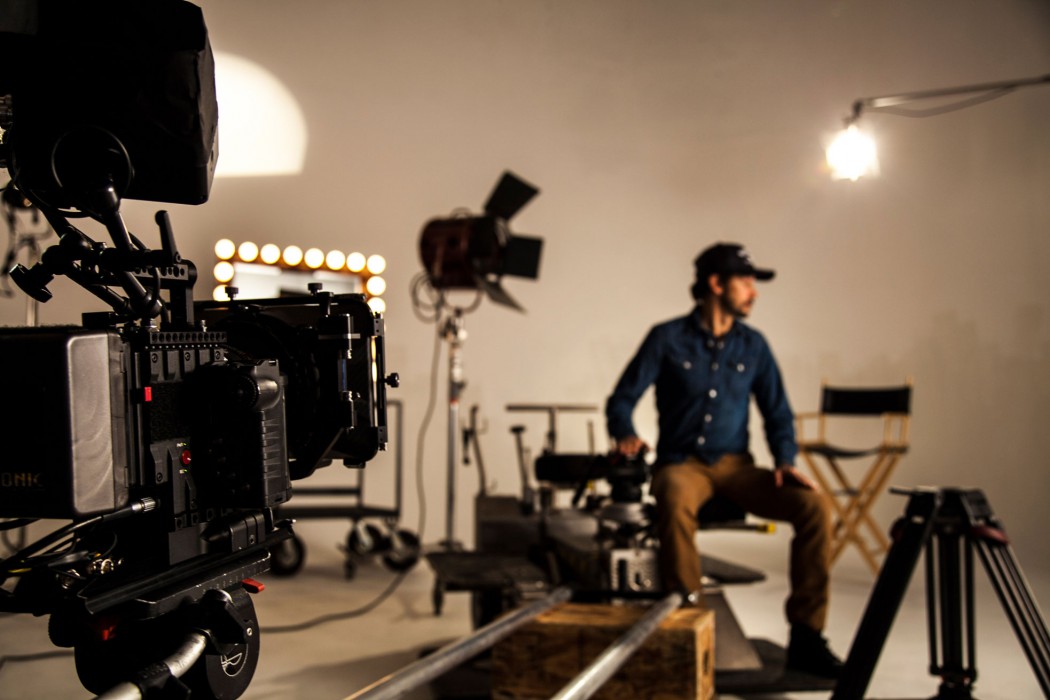Filmmaking or film production is the process by which a motion picture is produced. Filmmaking involves a number of complex and discrete stages, beginning with an initial story, idea, or commission. Production then continues through screenwriting, casting, pre-production, shooting, sound recording, post-production, and screening the finished product before an audience, which may result in a film release and exhibition. The process is nonlinear, as the director typically shoots the script out of sequence, repeats shots as needed, and puts them together through editing later. Filmmaking occurs in a variety of economic, social, and political contexts around the world, and uses a variety of technologies and cinematic techniques to make theatrical films, episodic films for television and streaming platforms, music videos, and promotional and educational films.
Although filmmaking originally involved the use of film, most film productions are now digital. Today, filmmaking refers to the process of crafting an audio-visual story commercially for distribution or broadcast.

In pre-production, every step of actually creating the film is carefully designed and planned. This is the phase where one would narrow down all the options of the production. It is where all the planning takes place before the camera rolls and sets the overall vision of the project. The production company is created and a production office established. The film is pre-visualized by the director and may be storyboarded with the help of illustrators and concept artists. A production budget is drawn up to plan expenditures for the film. For major productions, insurance is procured to protect against accidents. Pre-production also includes working out the shoot location and casting process. The Producer hires a Line Manager or a Production Manager to create the schedule and budget for the film.
The nature of the film, and the budget, determine the size and type of crew used during filmmaking. Many Hollywood blockbusters employ a cast and crew of hundreds, while a low-budget, independent film may be made by a “skeleton crew” of eight or nine (or fewer). These are typical crew positions:

In production, the film is created and shot. In this phase, it is key to keep planning ahead of the daily shoot. The primary aim is to stick to the budget and schedule, which requires constant vigilance. More crew will be recruited at this stage, such as the property master, script supervisor, assistant directors, stills photographer, picture editor, and sound editors. These are the most common roles in filmmaking; the production office will be free to create any unique blend of roles to suit the various responsibilities needed during the production of a film. Communication is key between the location, set, office, production company, distributors and all other parties involved.
A typical day shooting begins with the crew arriving on the set/location by their call time. Actors usually have their own separate call times. Since set construction, dressing and lighting can take many hours or even days, they are often set up in advance.

The grip, electric and production design crews are typically a step ahead of the camera and sound departments: for efficiency’s sake, while a scene is being filmed, they are already preparing the next one.
While the crew prepares their equipment, the actors do their costumes and attend the hair and make-up departments. The actors rehearse the script and blocking with the director, and the camera and sound crews rehearse with them and make final tweaks. Finally, the action is shot in as many takes as the director wishes. Most American productions follow a specific procedure:
The assistant director (AD) calls “picture is up!” to inform everyone that a take is about to be recorded, and then “quiet, everyone!” Once everyone is ready to shoot, the AD calls “roll sound” (if the take involves sound), and the production sound mixer will start their equipment, record a verbal slate of the take’s information, and announce “sound speed”, or just “speed”, when they are ready. The AD follows with “roll camera”, answered by “speed!” by the camera operator once the camera is recording. The clapper loader, who is already in front of the camera with the clapperboard, calls “marker!” and slaps it shut. If the take involves extras or background action, the AD will cue them (“action background!”), and last is the director, telling the actors “Action!”. The AD may echo “action” louder on large sets.
A take is over when the director calls “Cut!” and the camera and sound stop recording. The script supervisor will note any continuity issues, and the sound and camera teams log technical notes for the take on their respective report sheets. If the director decides additional takes are required, the whole process repeats. Once satisfied, the crew moves on to the next camera angle or “setup”, until the whole scene is “covered.” When shooting is finished for the scene, the assistant director declares a “wrap” or “moving on”, and the crew will “strike”, or dismantle, the set for that scene.
At the end of the day, the director approves the next day’s shooting schedule and a daily progress report is sent to the production office. This includes the report sheets from continuity, sound, and camera teams. Call sheets are distributed to the cast and crew to tell them when and where to turn up the next shooting day. Later on, the director, producer, other department heads, and, sometimes, the cast, may gather to watch that day or yesterday’s footage, called dailies, and review their work.


With workdays often lasting fourteen or eighteen hours in remote locations, film production tends to create a team spirit. When the entire film is “in the can”, or in the completion of the production phase, it is customary for the production office to arrange a wrap party, to thank all the cast and crew for their efforts.
For the production phase on live-action films, synchronizing work schedules of key cast and crew members is very important. For many scenes, several cast members and many crew members must be physically present at the same place at the same time (and bankable stars may need to rush from one project to another). Animated films have different workflow at the production phase, in that voice actors can record their takes in the recording studio at different times and may not see one another until the film’s premiere. Animated films also have different crew, since most physical live-action tasks are either unnecessary or are simulated by various types of animators.

This stage is usually thought of as starting when principal photography ends, but they may overlap. The bulk of post-production consists of the film editor reviewing the footage with the director and assembling the film out of selected takes. The production sound (dialogue) is also edited; music tracks and songs are composed and recorded if a film is intended to have a score; sound effects are designed and recorded. Any computer-generated visual effects are digitally added by an artist. Finally, all sound elements are mixed down into “stems”, which are synchronized to the images on the screen, and the film is fully completed (“locked”).


Filmmaking also takes place outside of the mainstream and is commonly called independent filmmaking. Since the introduction of DV technology, the means of production have become more democratized and economically viable. Filmmakers can conceivably shoot and edit a film, create and edit the sound and music, and mix the final cut on a home computer. However, while the means of production may be democratized, financing, traditional distribution, and marketing remain difficult to accomplish outside the traditional system. In the past, most independent filmmakers have relied on film festivals (such as Sundance Film Festival, Venice Film Festival, Cannes Film Festival, and Toronto International Film Festivals) to get their films noticed and sold for distribution and production. However, the internet has allowed for the relatively inexpensive distribution of independent films on websites such as YouTube. As a result, several companies have emerged to assist filmmakers in getting independent movies seen and sold via mainstream internet marketplaces, often adjacent to popular Hollywood titles. With internet movie distribution, independent filmmakers who choose to forego a traditional distribution deal now have the ability to reach global audiences.